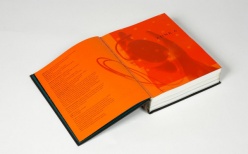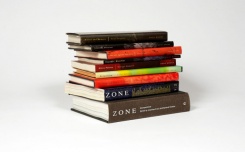Theory
Practice
Who is the author?
Structuralism / Poststructuralism
Interaction/ Narrative / Games
Sensory engagement
ReMix Culture
Collaboration
Pachube
Typographical Treatment
Data Gathering
Data Visualization
Dreamweaver
Collaborative Film Making
Arduino Workshop
Final Project
Flash

Explain and critique the idea of ‘the birth of the reader’ put forward by Roland Barthes using a range of design works of your choice as examples, making use of other writers work to illustrate the strengths and weaknesses of the concept
The idea put forward by Roland Barthes in his famous essay ‘Death of the author’ proclaims that authorship as a way of validation is outdated and that the text has multi layered meanings which does not necessarily need to reflect the true author themselves. Barthes finishes his essay by saying: “To give writing its future, it is necessary to overthrow the myth: the birth of the reader must be at the cost of the death of the author.” (Roland Barthes, 1977 in Authorship: From Plato to the Postmodern, p.130). His idea has been highly controversial but very influential during the poststructuralist period and has received many response essays trying to further discuss and answer the question about authorship, and the importance of having an author at all.
In this essay I will look at this question and how it has influenced the graphic design world by looking at significant writers, such as Michael Rock and his essay “Graphic Authorship”, Beatrice Wardes essay “The Crystal Goblet”, and also Michael Foucault’s essay “What is an author? ”. I will also use design examples produced by the curator, book writer and designer Ellen Lupton, Canadian designer Bruce Mau, and New York based graphic designer and typographer Stefan Sagmeister, to illustrate the strengths and weaknesses of the concept. In order to better understand the reasons and origins of the role of the designer, the role of the reader, and what makes good design, I will explore and discuss the differences between the Structuralist and Poststructuralist movements.
One of the main poststructuralist theories is openness and instability of meaning in order to create a spirit. Poststructuralist ideas were developed in opposition to analytical, organized structuralism neutrality. From the nineteenth seventies Katherine McCoy was emphasizing to her students that emotion and self-expression are more important aspects of the design process than the actual message itself, bringing back the attention to the individual designer, his/hers feelings whilst at the same time critically engaging society.1
In his essay “Death of the Author” Roland Barthes wrote: ‘Text is not a line of words releasing a single ‘theological’ meaning (the ‘message’ of the Author–God) but multi-dimensional space.’ (Roland Barthes, 1977 in Authorship: From Plato to the Postmodern, p.128)
By this Barthes is giving the impression that text is an open space, where the reader can find many meanings that are hidden there by the author. This approach to designing was very characteristic between poststructuralist artists, who believed that designs should provide open structures that encourage the audience’s participation and interpretation, also allowing the creator to put his emotion in to the design. It is not surprising that this period in history is associated with social revolutions where people rebelled against previous systems, and were striving for reform and freedom of speech. Warren Lehrer is a well-known writer and designer of the post-modernism movement, and whom was a pioneer in fields of visual literature and design authorship. For example, his designed book “French Fries” (1984) written by Dennis Bernestein, was designed using various typefaces, type sizes, images and shapes arranged in layered compositions. It was created with the aim to challenge the audience to break out from conventional, linear reading and instead allow the reader to experience freedom of choice; where to start reading or which paragraphs to skip.2 His design is emphatic, very energetic and busy, almost like he painted the surrounding scene using typography and shapes. There are no rules or precision in it's execution, promoting a strong authors presence and a sense of authenticity. Lehrer's participation in the input of ideas towards producing this book was on the same level as writer Dennis Bernestein.
Only by fully participating in the process of design and lending the amount of creative input that comes from a designer, can he then claim to have the same level of authorship of the design.
Whilst this post-structuralist approach to design can be very creative and visually expressive it has also got potential complications. Adopting this attitude can sometimes create a disconnection between the client and the audience, especially if the designer is producing work for a paying client who has got in mind a predefined idea of what meaning and emotion a piece of design should deliver. Consequently the masses engaging with very expressive and subjective pieces of design can potentially misinterpret the meaning beneath it and it can lead to unpleasant misunderstanding, which would further lead to the failure of delivering message that was intended.
Structuralism is a philosophical movement in Europe which was most influential during the period of the late 19th century up until the 1960's. The Structuralist movement believed in order and the necessity to take a systematic approach in their work. This is when graphic design becomes a profession and where the designer acts as a transmitter of the information between the client and the audience. Pioneer of Swiss Graphic Design Josef Müller–Brockmann alleged: ‘The withdrawal of the personality of the designer behind the idea, the themes, the enterprise, or the product is what the best minds are all striving to achieve.’ (Josef Müller–Brockmann,1968 in Graphic Design Theory, 2009, p.10) Structuralist designers were more concerned about analysis of language, culture and society, rather than their freedom of expression. They acknowledge that they are not just working to enjoy themselves and regard the clients message as the most important part of the design process. The designers role is to find the best way of presenting a clients work so that it purely delivers the message and without evidence of the designers influence. In this instance, the author of the text is perceived as god and that he or she should remain unchallenged by the design; the role of the designer is simply to find the meaning that already exists in the authors work.
In the famous essay by Beatrice Warde “The Crystal Goblet” she explains that typography should be purely for holding the information and compared it to a crystal goblet, where you can pour wine and see it through the glass in a pure way.3 In her opinion any input from the designer can alter the original message coming from the author, leading to confusion and distraction, and also changing the purity of the initial meaning.
Peoples tastes vary depending on their level of knowledge of the world, taking into consideration evolutionary factors such as their cultural background, political differences, religious beliefs etc., and therefore their understanding of what is acceptable and what is not alters. If the designer does not take in to account this simple notion and does not study his or hers audience before designing any self-expressive piece of design, it can lead to alienation. People may be put off by provocative or inappropriate pieces of design, which would lead to information not being delivered properly, and therefore the designers task fails.
This argument is evident in the AIGA lecture poster created by Stefan Sagmeister (1999), where information about the lecture is carved into his skin. Whilst it may be a good way of expressing his pain and lengths he went through to realise his work, some people might be so disgusted by seeing scars on someone else's body that they would refuse to read it, and avoid looking at it. Such a situation could prove distracting and result in those individuals missing key information about where/when this lecture would take place, as a direct result of the shocking nature of the design. Other people may also be put off by looking at a naked man's body, which could be connected with religious believes.
Successful design is all about creating a balance, where the designer has got enough space for self-expression and the reader has got the freedom of thought and interpretation. Therefore it is crucial that the designer is involved from the very beginning of the production process.
Bruce Mau was one of the earliest designers to deliberately experiment with the concept of 'designer as author'. He believed that in order to claim ownership of the design and delivering a clear message to the audience, it is integral that the designer should work side by side with writers during the initial stages of production. By getting involved in research and working along side other creative people it enables them to gain more valuable feedback about an idea. Working in such close proximity with the client provides the designer with best understanding of the concept and allows them to fully take control of tailoring the project, whilst suiting both the need of the client and the audience. One of Bruce Mau's best examples of the designer having a shaping role in the design process is his work in the publication, Zone Books (1986).
Having a close working relationship with the client is definitely the best way of delivering a clear message to the target audience and in the most appropriate manner. However it is not always easy to find a client that would put this amount of trust into the designer.
Some graphic designers choose to produce their own content for their design, like Ellen Lupton, who is an author and designer of numerous books and articles relating to design. Her unique design of books clearly reflect her love and passion for typography, writing and art in general. Ellen Lupton encourages designers to produce their own texts, as well as directing or changing the meaning of the text. She emphasizes the importance of paying equal attention to verbal and visual meaning.4 It may seem like a perfect solution of how designers can become authors, but there can be draw backs in making ones own content. This is because not all designers are necessarily good writers, and therefore books produced by designers for designers may struggle to relate to the broader audience. They are often very beautiful and interesting to look at, but somebody who is not involved in the design industry might find the information in them useless or irrelevant.
Working in collaboration with other designers and other creative people offers a greater opportunity to achieve successful design. It is very interesting how Michel Rock in his 1996 essay “The Designer as Author” draws parallels between the designer and the film director. For example, in the same way that it is essential that the director of a film works closely with editors and producers in order to produce a good film, designers need to work with writers, photographers and software developers (to name but a few).
A great example of how a collaborative environment can be prosperous is the collective of artists, designers, musicians and writers founded in 1991 called Tomato. Having this broad range of creative professionals inspiring and reinventing each others ideas allowed them to reach heights of success in the past 19 years.
There will always be some designers who’s work will be self-expressive, emotional and have multiple meanings solely based on his or hers understanding and knowledge, but without the intention to deliver specific ideas, or like Roland Barthes suggested – have multiple meanings. Others will produce very clean and structured design that follows all the aforementioned set rules embracing the 'holly grid' bypassing their own creativity in order to deliver the clear predefined message by the structuralist philosophy. It is not a modern idea that by working in collaboration with others it increases the opportunity of thinking up brilliant ideas culminating in the grandest of achievements. This way of working we know has been around for some time, and has become more significant than ever. Having an open-minded approach and creating balance by acting as facilitator is the key to successful design both now and in the future, actively sharing ideas throughout the whole design process. As defined in the famous english proverb: 'Two heads are better than one'.
It is also important to mention the impact of modern technology, and how it is used both as a tool for connecting design professionals as well as the design process itself. It has become increasingly easy for anybody to share and reuse material therefore offering seemingly endless opportunity, and thus giving designers the creative power to produce greater work than ever before.
Word count: 2039
Bibliography:
Books:
Armstrong, H., Lupton, E., 2009. Graphic Design Theory Readings From The Field. New York: Princeton Architectural Press.
Burke, S., 1995. Authorship: From Plato To The Postmoder. Edinburgh: Edinburgh Univerity Press.
Lupton, E., Miller, A., 1999. Design, Writing, Research Writing on Graphic Design. New York: Phaidon Press.
Poynor, R., 2003. No More Rules Graphic Design and Postmodernism. London: Laurence King Publishing.
Searle, J. 1969. Speech Acts: An Essay in the Philosophy of Language. Cambridge: Cambridge University Press.
Online resources:
Bruce Mau Design, 2011. Zone. http://www.brucemaudesign.com/4817/97552/work/zone [accessed 12December 2011].
Ellen Lupton, writer, designer, curator, critic, 2009. http://www.http://elupton.com/ [acessed 12December 2011].
Judith Sloan, Say. Books, French Fries. http://www.earsay.org/projects/books/warren-lehrer-and-dennis-bernstein-french-fries/ [accessed 14December 2011].
Sagmeister Inc. Work, posters. http://www.sagmeister.com/taxonomy/term/7#/node/5 [accessed 12December 2011].
TOMATOE, History. Available at: http://www.tomato.co.uk/#tomato-history/ [accessed 14December 2011].
The phrase finder, 1996 – 2011. The meaning and origin of the expression. http://www.phrases.org.uk/meanings/two-heads-are-better-than-one.html [accessed 14Dec 2011].
V&A channel. Postmodernism: The Substance of Style, video material. http://www.vam.ac.uk/channel/happenings/exhibitions_and_galleries/postmodernism_the_substance_of_style/ [accessed 10December 2011].



